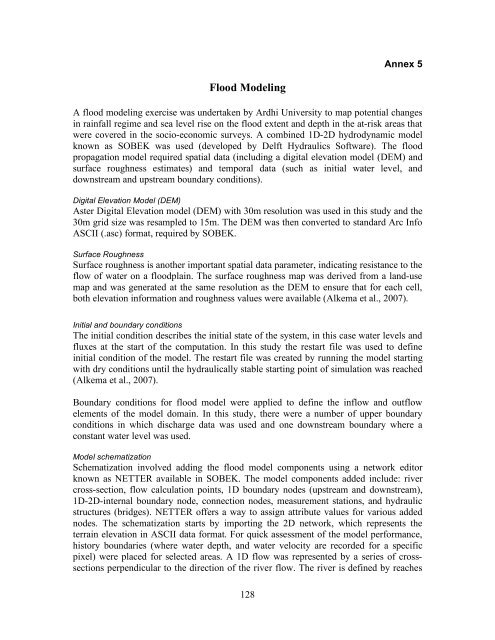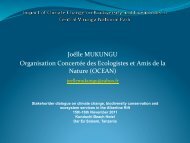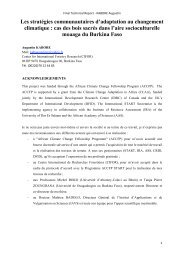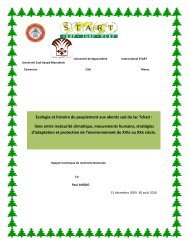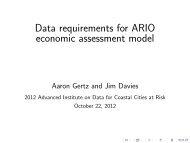Urban Poverty & Climate Change in Dar es Salaam, Tanzania:
Urban Poverty & Climate Change in Dar es Salaam, Tanzania:
Urban Poverty & Climate Change in Dar es Salaam, Tanzania:
Create successful ePaper yourself
Turn your PDF publications into a flip-book with our unique Google optimized e-Paper software.
Flood Model<strong>in</strong>g<br />
128<br />
Annex 5<br />
A flood model<strong>in</strong>g exercise was undertaken by Ardhi University to map potential chang<strong>es</strong><br />
<strong>in</strong> ra<strong>in</strong>fall regime and sea level rise on the flood extent and depth <strong>in</strong> the at-risk areas that<br />
were covered <strong>in</strong> the socio-economic surveys. A comb<strong>in</strong>ed 1D-2D hydrodynamic model<br />
known as SOBEK was used (developed by Delft Hydraulics Software). The flood<br />
propagation model required spatial data (<strong>in</strong>clud<strong>in</strong>g a digital elevation model (DEM) and<br />
surface roughn<strong>es</strong>s <strong>es</strong>timat<strong>es</strong>) and temporal data (such as <strong>in</strong>itial water level, and<br />
downstream and upstream boundary conditions).<br />
Digital Elevation Model (DEM)<br />
Aster Digital Elevation model (DEM) with 30m r<strong>es</strong>olution was used <strong>in</strong> this study and the<br />
30m grid size was r<strong>es</strong>ampled to 15m. The DEM was then converted to standard Arc Info<br />
ASCII (.asc) format, required by SOBEK.<br />
Surface Roughn<strong>es</strong>s<br />
Surface roughn<strong>es</strong>s is another important spatial data parameter, <strong>in</strong>dicat<strong>in</strong>g r<strong>es</strong>istance to the<br />
flow of water on a floodpla<strong>in</strong>. The surface roughn<strong>es</strong>s map was derived from a land-use<br />
map and was generated at the same r<strong>es</strong>olution as the DEM to ensure that for each cell,<br />
both elevation <strong>in</strong>formation and roughn<strong>es</strong>s valu<strong>es</strong> were available (Alkema et al., 2007).<br />
Initial and boundary conditions<br />
The <strong>in</strong>itial condition d<strong>es</strong>crib<strong>es</strong> the <strong>in</strong>itial state of the system, <strong>in</strong> this case water levels and<br />
flux<strong>es</strong> at the start of the computation. In this study the r<strong>es</strong>tart file was used to def<strong>in</strong>e<br />
<strong>in</strong>itial condition of the model. The r<strong>es</strong>tart file was created by runn<strong>in</strong>g the model start<strong>in</strong>g<br />
with dry conditions until the hydraulically stable start<strong>in</strong>g po<strong>in</strong>t of simulation was reached<br />
(Alkema et al., 2007).<br />
Boundary conditions for flood model were applied to def<strong>in</strong>e the <strong>in</strong>flow and outflow<br />
elements of the model doma<strong>in</strong>. In this study, there were a number of upper boundary<br />
conditions <strong>in</strong> which discharge data was used and one downstream boundary where a<br />
constant water level was used.<br />
Model schematization<br />
Schematization <strong>in</strong>volved add<strong>in</strong>g the flood model components us<strong>in</strong>g a network editor<br />
known as NETTER available <strong>in</strong> SOBEK. The model components added <strong>in</strong>clude: river<br />
cross-section, flow calculation po<strong>in</strong>ts, 1D boundary nod<strong>es</strong> (upstream and downstream),<br />
1D-2D-<strong>in</strong>ternal boundary node, connection nod<strong>es</strong>, measurement stations, and hydraulic<br />
structur<strong>es</strong> (bridg<strong>es</strong>). NETTER offers a way to assign attribute valu<strong>es</strong> for various added<br />
nod<strong>es</strong>. The schematization starts by import<strong>in</strong>g the 2D network, which repr<strong>es</strong>ents the<br />
terra<strong>in</strong> elevation <strong>in</strong> ASCII data format. For quick ass<strong>es</strong>sment of the model performance,<br />
history boundari<strong>es</strong> (where water depth, and water velocity are recorded for a specific<br />
pixel) were placed for selected areas. A 1D flow was repr<strong>es</strong>ented by a seri<strong>es</strong> of crosssections<br />
perpendicular to the direction of the river flow. The river is def<strong>in</strong>ed by reach<strong>es</strong>


